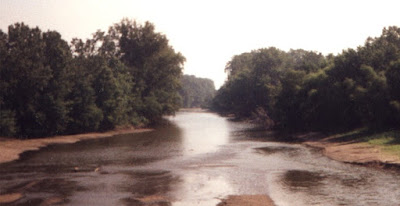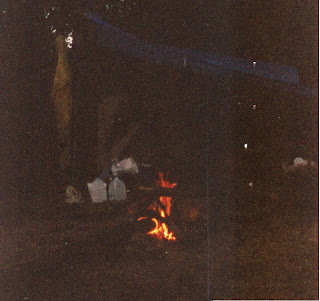Bait Basics for Catfishing
You're geared up and ready to head into battle with some catfish. Rods, reels, line, hooks, sinkers...you've got it ALL covered. Right??? Almost. But, you won't get many fish without some kind of bait. I like to spend more time fishing than collecting bait, so I try to keep things simple and efficient when it comes to bait.Basically, I figure there are two categories of baits...dead or alive. Dead baits are fairly easy to use, so I wont spend a lot of time on those. Dead bait could be frozen suckers or other fish, shrimp, dip baits, paste baits. Dip baits can be very effective for channel catfish, just stick a dip worm or tube in there and you're set. I prefer a single hook instead of the usual trebles, easier to remove. Or clip one of the tines with wire cutters if you want a double-hook rig.
Dead baits work great for channel catfish at times and are generally the easiest to handle. If you're using frozen baits, make sure you keep them good and cold. I also recommend keeping them in a separate cooler from your food and drinks. Common sense, right?
Most often, I prefer to fish with live baits. Live baits include worms (especially nightcrawlers) and a whole assortment of live fish. Worms are a good bait, but also appeal to non-catfish species like bullheads, carp, white bass, etc. Still, put a fat nightcrawler in front of a hungry channel cat and they will seldom turn it down. Worms are very too handy because you can catch some of these other species to use as live or cut bait. Be sure to observe the local rules and regulations with respect to what is and is not permissible in terms of using fish caught via hook and line as bait.
Many live baits like worms, minnows, suckers and shiners can be obtained from a local bait shop. When I was a kid, we caught a lot of channel catfish on large fathead minnows from the bait shop. When other baits were harder to come by we even baited trotlines and bankpoles with them. You can also use purchased baits as dead baits by smashing them, cutting them in half, or even freezing leftovers at the end of a trip. I have found that fresh baits seem to attract more fish and will stay on the hook better than frozen ones. Oily fish species like shad, shiners, or suckers tend to be great options for cut bait.
 Larger live baits like bullheads, creek chubs, shad, shiners, suckers, and sunfish appeal to both channel and flathead catfish. Mostly, I prefer to use these species for bait fish because they're generally easy to obtain and keep in good shape for a night of fishing. When I'm targeting flathead catfish, I prefer to use healthy and active live baits. Flatheads are attracted to the vibration and activity of these baits. Many believe that flathead catfish often attack live baits to defend their territory. The bait is essentially an invader and the easiest way for a flathead to eliminate this interloper is to attack or eat it. Problem solved.
Larger live baits like bullheads, creek chubs, shad, shiners, suckers, and sunfish appeal to both channel and flathead catfish. Mostly, I prefer to use these species for bait fish because they're generally easy to obtain and keep in good shape for a night of fishing. When I'm targeting flathead catfish, I prefer to use healthy and active live baits. Flatheads are attracted to the vibration and activity of these baits. Many believe that flathead catfish often attack live baits to defend their territory. The bait is essentially an invader and the easiest way for a flathead to eliminate this interloper is to attack or eat it. Problem solved.  When I'm fishing for baits before I fishing trip I'll use a garden worm, spike worm, or meal worm below a tiny float
on a #8 light wire hook. I love to use wild baits caught from tributary creeks or streams; I feel fish used to swimming in current tend to be more lively and active baits. I've used everything from bluegill, crappie, creek chubs, bullhead, and green sunfish. I especially like green sunfish and bullheads, they're so frisky and very hardy. Bullheads are about the toughest, easy to keep alive for quite a long time. Many catfish anglers use bluegills for bait, they are readily available and also are a very effective bait.
When I'm fishing for baits before I fishing trip I'll use a garden worm, spike worm, or meal worm below a tiny float
on a #8 light wire hook. I love to use wild baits caught from tributary creeks or streams; I feel fish used to swimming in current tend to be more lively and active baits. I've used everything from bluegill, crappie, creek chubs, bullhead, and green sunfish. I especially like green sunfish and bullheads, they're so frisky and very hardy. Bullheads are about the toughest, easy to keep alive for quite a long time. Many catfish anglers use bluegills for bait, they are readily available and also are a very effective bait.  When it's taking a while to catch baits on a hot summer day
it's good to keep the water aerated and circulating to reduce the amount
stress on the baits. Lively baits always seem to attract the most
catfish and minimizing stress helps tremendously. More on this topic later.
When it's taking a while to catch baits on a hot summer day
it's good to keep the water aerated and circulating to reduce the amount
stress on the baits. Lively baits always seem to attract the most
catfish and minimizing stress helps tremendously. More on this topic later. If you have a cast net and shad are available, you can always make a few throws to some of those. Again, just be sure to follow local rules regarding what species can be captured and what size nets can be used. I'm still trying to learn how to throw my cast net, so I rarely use it. But there are some great videos on YouTube where anglers demonstrate how to throw a cast net for bait. On waters with a healthy shad population, catfish anglers frequently use cast nets to obtain bait. Since shad is a primary forage species when available, it only makes sense they would be a great catfish bait in these instances.
 Keeping Live Baits Healthy
Keeping Live Baits Healthy
Fish are fish, and whether they're shad,
bluegills, or shiners water quality is a top
priority to keep live baits healthy. In order to keep baitfish happy, they require fresh water with adequate levels of dissolved oxygen. Cooler water will generally absorb more oxygen, and some type of aeration will help greatly. If you've ever had baits going belly-up on a hot summer day...they probably weren't getting enough oxygen.
bluegills, or shiners water quality is a top
priority to keep live baits healthy. In order to keep baitfish happy, they require fresh water with adequate levels of dissolved oxygen. Cooler water will generally absorb more oxygen, and some type of aeration will help greatly. If you've ever had baits going belly-up on a hot summer day...they probably weren't getting enough oxygen.
 Other factors
impacting oxygen levels include the surface area of your container (more
surface=more oxygen), and the levels of contaminants/ammonia in the water.
As fish respirate, they remove the oxygen from the water; at the same
time adding ammonia to the water through their waste. Once caught most fish quickly empty their waste adding nitrogen and
particle matter to the water. if you've caught wild baits from somewhere, it's a good idea to change their water within about 45 minutes.
This can be as easy as having a second bucket on hand with cool, conditioned tap-water. I use Jungle products Start Right to remove chlorine and condition. Overcrowding along with rising water
temperatures will also cause a rapid decline in the health of your
baits. So keep your baits happily swimming around in good quality water.
Other factors
impacting oxygen levels include the surface area of your container (more
surface=more oxygen), and the levels of contaminants/ammonia in the water.
As fish respirate, they remove the oxygen from the water; at the same
time adding ammonia to the water through their waste. Once caught most fish quickly empty their waste adding nitrogen and
particle matter to the water. if you've caught wild baits from somewhere, it's a good idea to change their water within about 45 minutes.
This can be as easy as having a second bucket on hand with cool, conditioned tap-water. I use Jungle products Start Right to remove chlorine and condition. Overcrowding along with rising water
temperatures will also cause a rapid decline in the health of your
baits. So keep your baits happily swimming around in good quality water. Other than leaving strainer buckets in the river, I tend to avoid local water during the summertime because the water gets too warm and dirty to use for extended periods. I've found over the years that an aerated container holding conditioned tap water from home or the bait shop seems to work best.
 I've been using a 12 volt-powered aerator for a number of years now. This model has a spray attachment that keeps the water circulating and well oxygenated. The pump which forces
water through a tube with holes/jets to spray back down on the surface. With this type of setup, you don't have to keep moving a strainer bucket in and out of the boat to keep
baits fresh. Plus, have you ever taken off with the bucket still in the
water? Another thing I like about my aerator system is that it's large enough for a 5 gallon bucket or a 48 quart cooler.
I've been using a 12 volt-powered aerator for a number of years now. This model has a spray attachment that keeps the water circulating and well oxygenated. The pump which forces
water through a tube with holes/jets to spray back down on the surface. With this type of setup, you don't have to keep moving a strainer bucket in and out of the boat to keep
baits fresh. Plus, have you ever taken off with the bucket still in the
water? Another thing I like about my aerator system is that it's large enough for a 5 gallon bucket or a 48 quart cooler.On a related note, I made a quick video about
catching baits for the YouTube channel. Just basic creek fishing technique that works for sunfish, bullheads, creek chubs, etc.Good luck and good fishing!



















































